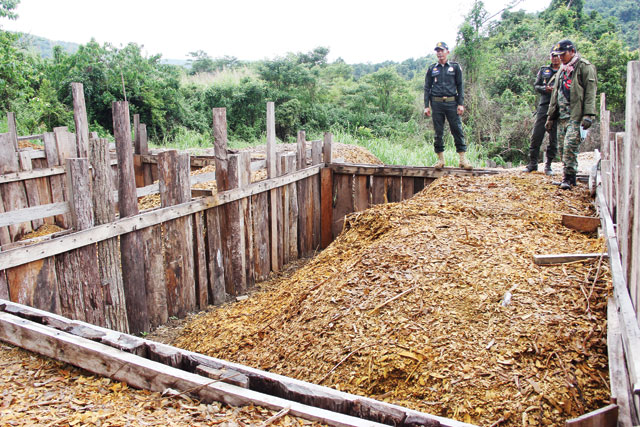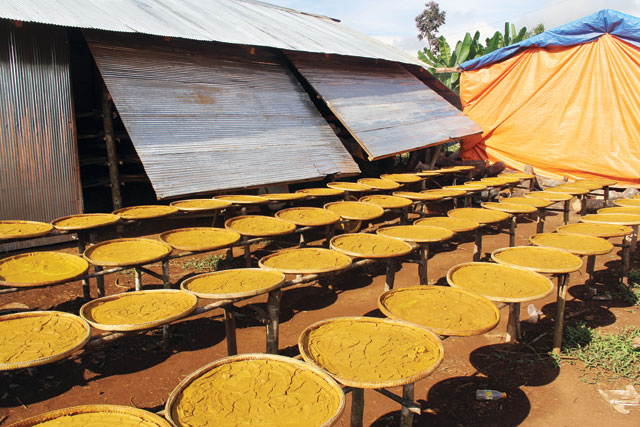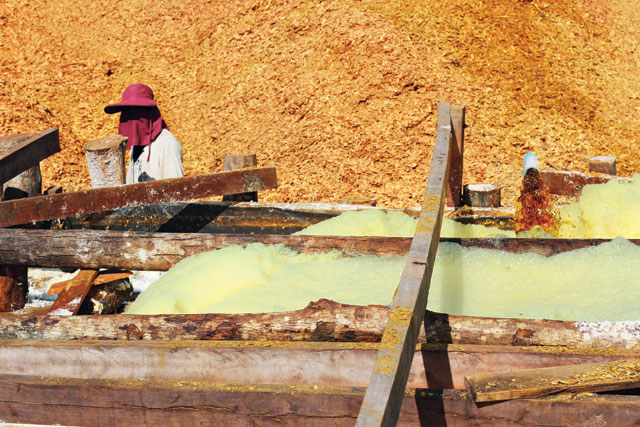THE FACTORY
The smell is noxious – something sour, sharp and sweet like sulphur mixed with palm sugar – and it permeates the sprawling, makeshift factory that has been slashed out of the jungle in southwestern Cambodia’s Cardamom Mountains. Around it, the charred stumps of ancient trees stand sentinel while, inside, masked workers busy themselves over vats and trays as they transform a woody vine they call vohr romiet into powdery nuggets the colour of ochre.
Ask them what the powder is being used for, and they say medicine, lotions or: “I don’t know.” In Phnom Penh, conservationists guess that it is an ingredient in cosmetics, herbal remedies or narcotics. Ask where it goes, and you’ll hear Singapore, Thailand, Vietnam or China.

“I’m not sure what they’re doing with it, but I heard it’s used for cosmetics and dyes.”
When it comes to yellow vine, everyone has more questions than answers.
A team of forest rangers spreads through the factory. Overseen by conservation NGO Wildlife Alliance (WA), their mission is to survey the site. The rangers are edgy – prominent Cambodian environmentalist Chut Wutty was shot to death shortly after photographing stockpiles of yellow vine near a similar factory in April 2012.
“He thought it was linked with drug production,” says Olesia Plokhii, a former Cambodia Daily journalist who was with Wutty at the time of his murder. “That was the whole reason we took the trip with him.” Plokhii would later write about the incident for Newsweek.
The place is filled with the hum and clatter of generators, pumps and engines. Bundles of vine are being brought to the factory from across the Cardamoms. Grey on the outside with a dandelion core, they drip yellow when cut. The vines are placed in a woodchipper, then baskets of chips are thrown into massive wooden vats where they’re bathed in a mixture that is believed to contain sulphuric acid. After ten days, salt is added to thicken the frothy cocktail, which is mixed using propellers fixed to battered tractor engines. The chemical effluent is dumped, and the yellow gunk lining the bottom of the vats is collected, then put in bamboo trays and sunned. Once dry, the resulting cake is broken into smaller pieces and laid out on the ground.
Made of wood, tarpaulin and corrugated iron, the entire factory has a ramshackle, impermanent feel. I count more than 40 vats and hundreds of drying trays. Tubs of chloride and hydrogen peroxide could also be found. Workers claim to make $200 a month, plus room and board – a decent sum for a rural Cambodian. Throughout the site, rows of banana plants grow in soil contaminated with chemical effluent.
We don’t stay long.
Located in Pursat province’s Veal Veng district, the factory is registered to MDS Import Export – a firm owned by Cambodian logging tycoon Try Pheap. According to a 2013 report by Cambodia Human Rights Task Force, a local NGO, companies belonging to Try Pheap and his wife hold permits to exploit and develop more than 70,000 hectares of land in Cambodia, nearly seven times the legal limit – an allegation that Try Pheap has denied. His companies have also been accused of extensive logging in protected forests and displacing nearly 1,500 families.
Cambodia’s 2002 Forestry Law prohibits “establish[ing] yellow vine… processing facilities at a level that may cause significant pollution or significant harm to the forest ecosystem.” A 2006 sub-decree, moreover, makes it illegal to export both “yellow vine” and “yellow vine powder”. Nevertheless, MDS was given a permit to operate its factory by Cambodia’s Ministry of Agriculture, Forestry and Fisheries (MAFF) in March last year. In exchange for paying royalties to MAFF and the government, MDS is permitted to collect the plant from the (now inundated) inundation zone of a controversial hydropower dam in the Central Cardamom Mountains so long as it does “not affect the forest and the surrounding environment”.
Clandestine yellow vine factories have operated in Cambodia’s southwest for more than two decades. Processing has occurred in waves – heavy exploitation, followed by periods in which the plant disappears, then regenerates. According to Marcus Hardtke, Southeast Asia programme coordinator for German conservation group ARA, until recently, yellow vine factories were largely considered illegal.
“The government and NGOs used to really crack down on these factories,” says Hardtke, who has been working on environmental issues in Cambodia since 1996. “They would burn them down… But when they began building dams in the Cardamom Mountains, suddenly a loophole was opened.”

Everywhere along the Cardamoms’ narrow dirt roads, we see signs of activity: motorbikes camouflaged with vegetation; bundles of yellow vine in ditches; farmers precariously balancing 60kg bundles of the stuff on their battered motorbikes; and lumbering jalopies piled high with the plant. Trekking in the ‘protected’ forest, we find machete-wielding men, women and children cutting the vine. Some attempt to flee. None of these people know what it is being used for, though some say that they boil the raw plant with water to treat fevers and stomach aches. If they sell direct to the factory, they can make about $0.10 per kilogram. The freelancing middlemen who ply the Cardamom Mountains’ roads in battered trucks pay roughly half of that.
“Many people from my village are doing this,” one man says. “It’s better money than working on a farm.”
The WA rangers see so much of the stuff that confiscation is out of the question.
The day after the mission, the team is bombarded with calls from Cambodia’s Forestry Administration – the body that oversees and enforces laws pertaining to Cambodia’s protected woodlands.
“I had a fun morning,” the WA team’s advisor tells me on the phone. “They’re pissed off and telling us that we can’t do anything about yellow vine.”
When asked where yellow vine powder is going and what it is being used for, a representative from MDS declined to comment. MAFF, which has granted several exclusive logging rights to Try Pheap firms, ignored multiple interview requests as well.
A Forestry Administration official, however, agreed to meet.
“Yellow vine?” he said. “I’m not sure what they’re doing with it, but I heard it’s used for cosmetics and dyes.”
The Investigation
Yellow vine is a colloquial term for Coscinium fenestratum: a woody climber indigenous to the tropical evergreen forests of South and Southeast Asia. Also known as Columbo wood, tree turmeric and Coscinium usitatum, the thick flowering vine produces clusters of fruit and can grow to lengths of 30 metres. According to Dr Nimal Gunatilleke, a botanist from Sri Lanka’s University of Peradeniya who has been studying C. fenestratum for more than two decades, the plant has been used for millennia in Ayurvedic medicine.
“It’s been traditionally used like paracetamol, for everything from headaches to fever – it even has antibiotic properties,” Dr Gunatilleke says. People travelling in Sri Lanka’s forests, he adds, suck on the raw vine to relieve aches and pains. “Now in Sri Lanka, they even make soap and toothpaste with it.”
The main medicinal compound in C. fenestratum is berberine – an isoquinoline alkaloid that is extracted from numerous plants worldwide. In addition to its traditional uses, recent experiments have shown that berberine may also be an effective antibacterial, antiviral, antidepressant, anticancer, antioxidant… the list goes on. Similar operations to the one in Cambodia operate openly in countries such as Laos, and the use of berberine in traditional medicines in places including Vietnam, Thailand, Sri Lanka, India and China has left C. fenestratum critically endangered.
An independent lab test conducted in December by UK-based Triple A Forensics concluded that the sample of Cambodian yellow vine powder they received via a conservation NGO is a substance containing berberine. The results of tests recently commissioned by Cambodia’s National Authority for Combatting Drugs were not available at time of publication.
In Cambodia, rumours have long persisted that yellow vine powder is being used to manufacture narcotics. Espoused by people such as Chut Wutty and propagated in a handful of stories in local and international media, such a view has been bolstered by the intense secrecy surrounding yellow vine factories as well as the fact that safrole-rich oil, a precursor in the manufacture of popular party drug MDMA/ecstasy, has long been processed in clandestine Cardamom-Mountain laboratories from the roots and bark of ancient Cinnamomum parthenoxylon trees.
The drug theory was given scientific backing by University of Texas botanist and Wutty associate Dr Andrew McDonald in Death in the Forest, a documentary programme about Wutty’s unsolved killing that appeared on Australia’s SBS television network in May 2012.
In the programme, Dr McDonald compares molecular diagrams of berberine and ecstasy, and concludes the structure of ecstasy is nestled into berberine’s back.
“Half of the compound is ecstasy,” Dr McDonald says in the programme. “In my opinion it’s likely, and I base that on not so much the fact it has the backbone of ecstasy in it, I base that on the fact that this extraction effort and the plant product itself disappears. It’s secretive and it’s taking place under armed guard in the recesses of the forest.”
In an e-mail exchange earlier this year, Dr McDonald restated this hypothesis:
“Now, the question is… is this conversion [from berberine to ecstasy] feasible, and if so, how many chemical steps would be required?… Both academic and clandestine chemists have told me that the conversion is feasible.”
Dr David Nichols is a pharmacologist and medicinal chemist at Purdue University, Indiana. For 45 years, he has both studied and synthesised psychoactive drugs, including MDMA.
“Seeing ‘ecstasy’ in there (and it’s actually not there) is not the same as being able to get it,” Dr Nichols said in a January email. “The conversion [from berberine to ecstasy] is not only not feasible, but in fact is impossible. I suppose you could burn it back to carbon dioxide and start building up aromatic rings from that, but it would be completely impractical.”
When asked if berberine could be used to synthesise illicit substances such as anabolic steroids or amphetamine-type stimulants (other rumoured uses for yellow vine), Dr Nichols’ answer was an unequivocal no. A leaked 2006 cable from the US Embassy in Phnom Penh corroborates this view.
According to a representative from Cambodia’s National Centre of Traditional Medicine, yellow vine has traditionally been used in Cambodia to treat ailments such as malaria and dysentery.

“The water is also affecting people’s health… Many are complaining of skin diseases.”
At the herbal-remedy wholesalers that sit across from Phnom Penh’s Orussey Market, dried, unprocessed yellow vine chips sell for $0.75 to $1 per kilogram. Throughout Asia, such chips have also traditionally been used to manufacture dyes.
“The powder is illegal,” one vendor tells me. “And even if we wanted to use it, at $20 per kilo, it’s too expensive for most Cambodians.” Nearby, a drink shop sells 500ml bottles of rice whiskey infused with yellow vine chips for $0.40.
“It’s popular with construction workers,” the shop’s owner says of the sharp-tasting yellow liquid that leaves me woozy. “It gives them energy and makes their muscles relax.”
Yellow vine powder, it seems, is destined for export.
An extensive search on Chinese online marketplace Alibaba.com – which has also hosted sales of illegally harvested Cambodian rosewood – reveals that International Medical Consultants (IMC), a Hanoi-based pharmaceutical company, is selling Cambodian berberine hydrochloride powder wholesale for $10 to $30 per kilogram. Available in 25kg tubs, the citrine-coloured powder looks nearly identical to what I saw in the Cardamom Mountains. On the same site, other vendors from China and Vietnam sell similar products for upwards of $100 per kilogram.
On its website, IMC sells numerous herbal concoctions, three of which contain C. fenestratum extract. Two of these products are marketed as a means to prevent and treat cardiovascular disease while a third is purported to enhance eyesight and prevent macular degeneration. Elsewhere online, berberine capsules are sold as a treatment for diabetes and high cholesterol.
So, it seems likely that Cambodia’s yellow vine factory is producing an ingredient for herbal remedies. This, however, still begs the question: Why all the secrecy?
Perhaps this relates to the factory’s dubious legal status – that is, it being given special permission to process and export a plant in direct contravention of an existing law. Such factories may also mask other forest crimes such as illegal logging and wildlife poaching. WA rangers, moreover, continue to find people illegally harvesting yellow vine deep in protected areas.
Perhaps cause for greatest concern is the environmental damage caused by the factory. In addition to encouraging clear-cutting, new roads and trails, and the unsustainable harvesting of the plant, the factory is also leaking chemical waste. When I visited last year, rivulets of toxic slurry were seeping from the factory’s vats and earthen detention ponds, and then entering a nearby stream.
Chhim Savuth, formerly an investigator with the Cambodian Centre for Human Rights, has interviewed people living downstream from the site.
“The acid the factory uses is destroying the forest and poisoning animals and fish,” he says. “The water is also affecting people’s health… Many are complaining of skin diseases.”
All of this suggests that MDS is violating the stipulations of its agreement with the MAFF. But perhaps the biggest reason for all the secrecy is that Try Pheap now has a government-sanctioned monopoly on a very lucrative trade. According to an official from Cambodia’s National Authority for Combatting Drugs, seven metric tonnes of raw yellow vine yields roughly 200kg of yellow vine powder in each vat. So – to boil it down – if 35kg of vine is needed to produce 1kg of powder, and if the factory is paying $0.10/kg for the raw plant, then wholesaling the powder for $20/kg, (factoring out labour, supplies and payoffs), that would mean $3.50 worth of vine creates $20 worth of powder – a more than fivefold return on investment. And that, perhaps, is a cost differential worth veiling.

